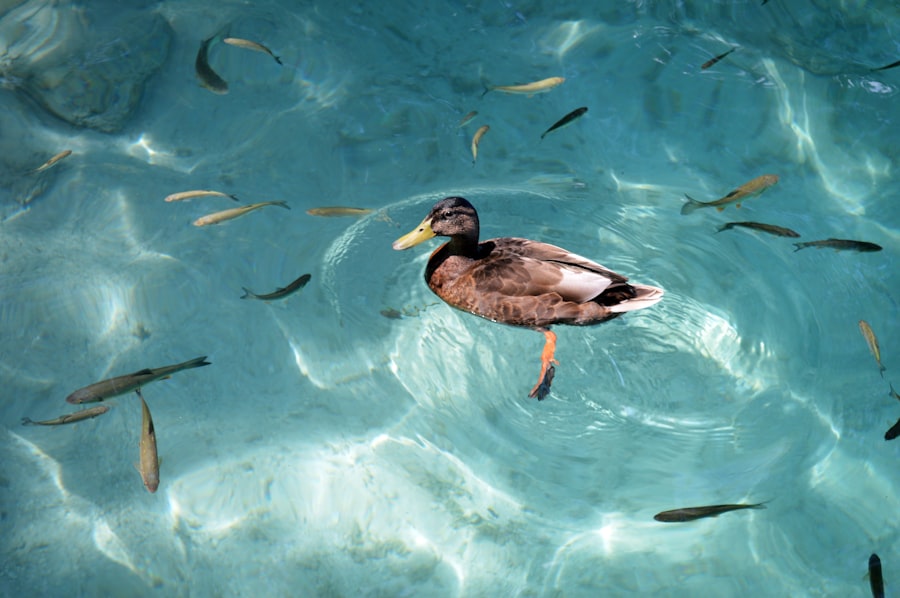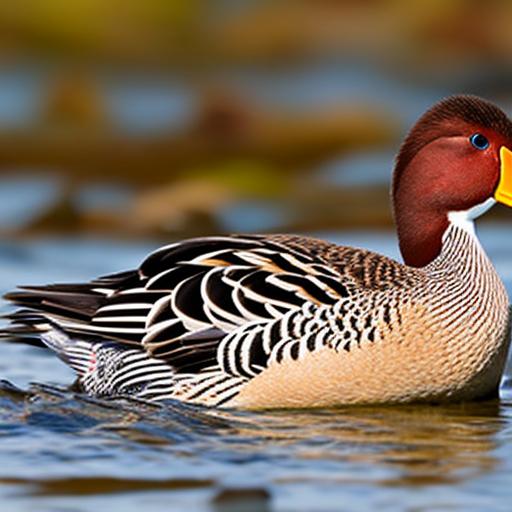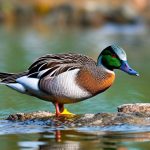Rare duck breeds are a unique and fascinating part of the poultry world. These breeds are characterized by their scarcity and distinct physical features, setting them apart from more common duck breeds. While many people are familiar with popular duck breeds like the Pekin or the Mallard, rare duck breeds offer a glimpse into the diversity and beauty of these waterfowl species.
Learning about rare duck breeds is important for several reasons. Firstly, it allows us to appreciate the rich history and heritage associated with these breeds. Many rare duck breeds have been around for centuries and have played significant roles in various cultures and societies. Secondly, understanding rare duck breeds helps us preserve their genetic diversity and prevent them from becoming extinct. By learning about these breeds and supporting conservation efforts, we can ensure that future generations will be able to appreciate their beauty and value.
Key Takeaways
- Rare duck breeds have unique characteristics and physical features that make them valuable for conservation and breeding purposes.
- The history of rare duck breeds dates back centuries and their significance lies in their genetic diversity and potential for adaptation to changing environments.
- Breeding and raising rare duck breeds requires specialized knowledge and attention to their specific needs, but can be a rewarding and profitable venture.
- Preserving rare duck breeds is important for maintaining biodiversity and ensuring the availability of genetic resources for future generations.
- Conservation organizations play a crucial role in protecting rare duck breeds and promoting their conservation through education and outreach efforts.
The History of Rare Duck Breeds and Their Significance
The origins of rare duck breeds can be traced back to different parts of the world. Some breeds, like the Indian Runner Duck, have their roots in Asia, while others, like the Cayuga Duck, originated in North America. These breeds were developed over time through selective breeding to enhance certain traits or adapt to specific environments.
Throughout history, rare duck breeds have served various purposes. Some were bred for their meat or eggs, while others were prized for their ornamental value. For example, the Aylesbury Duck was highly regarded for its tender meat and was popular in British cuisine during the 19th century. On the other hand, breeds like the Mandarin Duck were kept for their vibrant plumage and were often kept as decorative birds in gardens or parks.
The significance of rare duck breeds lies in their cultural and historical value. These breeds are a testament to our agricultural heritage and provide a connection to our ancestors who relied on them for sustenance or aesthetic pleasure. By preserving and learning about rare duck breeds, we can honor the traditions and practices of the past while also appreciating the unique qualities of these birds.
Characteristics and Physical Features of Rare Duck Breeds
Rare duck breeds exhibit a wide range of physical features that set them apart from more common breeds. These features can include unique feather patterns, distinct body shapes, or specialized adaptations for their natural habitats.
One example of a rare duck breed with unique physical features is the Crested Duck. As the name suggests, this breed has a prominent crest of feathers on its head, giving it a distinctive appearance. Another example is the Silver Appleyard Duck, which is known for its striking plumage that combines shades of silver, white, and brown.
Identifying rare duck breeds can be challenging for those who are not familiar with them. However, there are certain characteristics to look out for. These can include feather coloration, body size and shape, bill shape, and leg color. Consulting breed standards or seeking guidance from experienced breeders can also be helpful in correctly identifying rare duck breeds.
What makes rare duck breeds truly unique is their combination of physical features and traits. Each breed has its own set of characteristics that make it special and different from others. Whether it’s the distinctive call of the Muscovy Duck or the elegant posture of the Rouen Duck, these breeds offer a diverse array of traits that make them fascinating to study and appreciate.
Breeding and Raising Rare Duck Breeds: Tips and Tricks
Breeding and raising rare duck breeds can be a rewarding experience for poultry enthusiasts. However, it requires careful planning and attention to detail to ensure success. Here are some tips and tricks for breeding and raising rare duck breeds:
1. Research the breed: Before embarking on breeding rare duck breeds, it’s important to thoroughly research the specific breed you are interested in. Learn about their unique requirements, temperament, and any potential health issues they may be prone to. This will help you provide the best care and create optimal breeding conditions.
2. Select healthy breeding stock: When choosing breeding stock, it’s crucial to select healthy birds with desirable traits. Look for birds that are free from genetic defects or diseases and have good conformation to the breed standard. This will help ensure that the offspring inherit the best qualities of the breed.
3. Provide appropriate housing and environment: Rare duck breeds have specific housing and environmental needs that must be met for them to thrive. Provide a clean and spacious enclosure with access to fresh water for swimming. Ensure that the temperature and humidity levels are suitable for the breed, as some rare duck breeds are more sensitive to extreme weather conditions.
4. Feed a balanced diet: Proper nutrition is essential for the health and well-being of rare duck breeds. Feed a balanced diet that includes a mix of commercial duck feed, fresh vegetables, and protein sources. Consult with a poultry nutritionist or experienced breeder to determine the specific dietary requirements of your chosen breed.
5. Monitor breeding behavior: Pay close attention to the breeding behavior of your ducks. Observe mating rituals, nesting habits, and egg-laying patterns to ensure successful reproduction. Provide suitable nesting boxes or areas for broody ducks to lay their eggs and incubate them if necessary.
6. Seek veterinary care when needed: If you encounter any health issues or concerns with your rare duck breeds, it’s important to seek veterinary care promptly. Find a veterinarian who is knowledgeable about poultry and can provide appropriate treatment or advice.
While breeding and raising rare duck breeds can be challenging at times, it is also a rewarding endeavor that allows you to contribute to the preservation of these unique birds.
The Importance of Preserving Rare Duck Breeds for Future Generations
Preserving rare duck breeds is crucial for several reasons. Firstly, these breeds represent an important part of our agricultural heritage and cultural identity. They are a living link to our past and provide insight into the practices and traditions of previous generations. By preserving rare duck breeds, we can ensure that future generations will have the opportunity to learn about and appreciate these birds.
Secondly, rare duck breeds contribute to genetic diversity within the poultry population. Genetic diversity is essential for the long-term survival and adaptability of a species. By maintaining a diverse gene pool, we can help safeguard against the negative effects of inbreeding and increase the resilience of these breeds to environmental changes or disease outbreaks.
Furthermore, rare duck breeds often possess unique traits or characteristics that can be valuable for future breeding programs. These traits may include disease resistance, superior meat or egg quality, or specific adaptations to certain environments. By preserving rare duck breeds, we are preserving the potential for future advancements in poultry breeding and production.
To get involved in preserving rare duck breeds, there are several steps you can take. Firstly, support local breeders who specialize in rare duck breeds by purchasing birds or eggs from them. This helps ensure that these breeders can continue their conservation efforts and maintain their flocks. Additionally, consider joining or supporting conservation organizations that focus on rare duck breeds. These organizations often provide resources, education, and networking opportunities for individuals interested in preserving these breeds.
The Economics of Rare Duck Breeds: Market Demand and Profitability

While the primary motivation for preserving rare duck breeds is often their cultural or historical value, there is also a market demand for these birds. Rare duck breeds can be sold as breeding stock, pets, or for meat and egg production. This presents an opportunity for breeders to make a profit while also contributing to the preservation of these breeds.
The market demand for rare duck breeds varies depending on factors such as location, breed popularity, and consumer preferences. Some rare duck breeds may have a niche market with dedicated enthusiasts who are willing to pay a premium for these birds. Others may have broader appeal and can be sold to a wider customer base.
Profitability in raising rare duck breeds depends on several factors. These include the cost of acquiring breeding stock, the expenses associated with housing and feeding the birds, and the potential income from selling offspring or products. It’s important to carefully calculate the costs and potential returns before embarking on a breeding program to ensure that it is financially viable.
To maximize profitability while preserving the breed, consider diversifying your income streams. For example, in addition to selling breeding stock, you could also offer services such as hatching eggs or providing consulting for other breeders. Additionally, explore value-added products such as duck meat or eggs that can be sold directly to consumers or through local markets.
Popular Rare Duck Breeds and Their Unique Qualities
There are numerous rare duck breeds, each with its own unique qualities and characteristics. Here are some popular rare duck breeds and what sets them apart:
1. Indian Runner Duck: Known for their upright posture and distinctive running gait, Indian Runner Ducks are highly active and excellent foragers. They come in a variety of colors and are popular for their egg-laying abilities.
2. Cayuga Duck: The Cayuga Duck is named after Cayuga Lake in New York, where it was first developed. It is known for its beautiful iridescent black plumage that shines with shades of green and purple in the sunlight.
3. Silver Appleyard Duck: The Silver Appleyard Duck is a large breed known for its striking plumage that combines shades of silver, white, and brown. It is a dual-purpose breed, valued for both its meat and egg production.
4. Saxony Duck: Originating from Germany, the Saxony Duck is a medium-sized breed with beautiful blue-gray plumage. It is known for its calm temperament and excellent meat and egg production.
5. Muscovy Duck: The Muscovy Duck is a unique breed that is native to Central and South America. It is known for its distinctive appearance, with a red, warty face and a large size. Muscovy Ducks are valued for their lean meat and ability to control pests.
Each rare duck breed has its own set of qualities that make it special and suitable for different purposes. Whether you are looking for a breed with excellent egg-laying abilities, striking plumage, or superior meat quality, there is likely a rare duck breed that fits your needs.
Challenges and Obstacles in Raising Rare Duck Breeds
Raising rare duck breeds comes with its own set of challenges and obstacles. It’s important to be aware of these challenges and prepare accordingly to increase the chances of success. Here are some common challenges you may encounter when raising rare duck breeds:
1. Limited availability: Rare duck breeds are by definition scarce, which means that finding breeding stock can be challenging. It may require extensive research, networking with other breeders, or traveling long distances to acquire the desired birds.
2. Genetic issues: Some rare duck breeds may have a higher risk of genetic defects or health issues due to their limited gene pool. It’s important to carefully select breeding stock and monitor the health of the flock to minimize the risk of passing on genetic problems to future generations.
3. Specialized care requirements: Rare duck breeds may have specific care requirements that differ from more common breeds. For example, some breeds may be more sensitive to extreme temperatures or require access to natural bodies of water for swimming. It’s important to understand and provide for these specialized needs to ensure the well-being of the birds.
4. Market demand and competition: While there is a market demand for rare duck breeds, it can be competitive, especially if you are targeting a niche market. It’s important to differentiate your offerings and find ways to stand out from the competition. This can include emphasizing the unique qualities of your birds, offering value-added products, or providing exceptional customer service.
To overcome these challenges, it’s important to be well-prepared and knowledgeable about the breed you are raising. Seek advice from experienced breeders, join online forums or social media groups dedicated to rare duck breeds, and continuously educate yourself about best practices in breeding and raising these birds.
The Role of Conservation Organizations in Protecting Rare Duck Breeds
Conservation organizations play a crucial role in protecting and preserving rare duck breeds. These organizations are dedicated to the conservation and promotion of rare breeds, often through breeding programs, education, and advocacy efforts.
Conservation organizations work to maintain and increase the genetic diversity of rare duck breeds by carefully managing breeding programs. They often keep detailed records of pedigrees and monitor the health and genetic traits of individual birds. This helps ensure that breeding stock is selected with care and that the offspring have the best chance of inheriting desirable traits.
In addition to breeding programs, conservation organizations also provide education and resources for individuals interested in rare duck breeds. They may offer workshops, seminars, or online resources that cover topics such as breed identification, breeding techniques, and care requirements. By sharing knowledge and expertise, these organizations empower individuals to contribute to the preservation of rare duck breeds.
Getting involved in conservation efforts for rare duck breeds can be as simple as supporting these organizations through donations or membership fees. By doing so, you are helping fund their programs and initiatives that directly benefit these breeds. Additionally, consider volunteering your time or expertise to assist with breeding programs or educational activities. This hands-on involvement can be a rewarding way to contribute to the preservation of rare duck breeds.
Why Rare Duck Breeds are Worth the Investment
Rare duck breeds offer a unique and valuable opportunity for poultry enthusiasts to connect with our agricultural heritage, preserve genetic diversity, and contribute to the future of poultry breeding. By learning about, breeding, and raising rare duck breeds, we can ensure that these birds continue to thrive and enrich our lives for generations to come.
While raising rare duck breeds may come with its challenges, the rewards far outweigh the obstacles. The cultural and historical significance of these breeds, their unique physical features, and their potential for future advancements in poultry breeding make them worth investing time and resources in.
Whether you are a seasoned breeder or a novice enthusiast, there are many ways to get involved in preserving rare duck breeds. Support local breeders, join conservation organizations, educate yourself about best practices, and share your knowledge with others. By working together, we can ensure that rare duck breeds continue to grace our farms, gardens, and hearts for years to come.
If you’re interested in rare duck breeds, you might also want to check out this article on large chicken coop ideas. While it may seem unrelated at first, the principles of designing a spacious and comfortable coop for chickens can also be applied to ducks. A well-designed coop is essential for the health and happiness of your feathered friends, regardless of their species. So, why not explore some creative ideas for housing your rare duck breeds in style? You can find more inspiration in this article: https://poultrywizard.com/keeping-chickens/large-chicken-coop-ideas/.
FAQs
What are rare duck breeds?
Rare duck breeds are those that are not commonly found or raised in large numbers. These breeds may have unique physical characteristics, colors, or patterns that set them apart from more common breeds.
What are some examples of rare duck breeds?
Some examples of rare duck breeds include the Silver Appleyard, Saxony, Blue Swedish, Buff Orpington, and Cayuga. Other rare breeds include the Ancona, Magpie, and Welsh Harlequin.
Why are rare duck breeds important?
Rare duck breeds are important for genetic diversity and conservation efforts. By preserving these breeds, we can ensure that their unique traits and characteristics are not lost forever. Additionally, some rare breeds may have desirable traits that could be useful in breeding programs.
Where can I find rare duck breeds?
Rare duck breeds can be found through specialty breeders, poultry shows, and online marketplaces. It is important to do research and find a reputable breeder who can provide information on the breed’s history, care, and specific needs.
What should I consider before raising rare duck breeds?
Before raising rare duck breeds, it is important to consider their specific needs and requirements. Some breeds may require more space, specialized diets, or unique housing arrangements. Additionally, it is important to consider the availability of veterinary care and the potential for disease outbreaks.
Meet Walter, the feathered-friend fanatic of Florida! Nestled in the sunshine state, Walter struts through life with his feathered companions, clucking his way to happiness. With a coop that’s fancier than a five-star hotel, he’s the Don Juan of the chicken world. When he’s not teaching his hens to do the cha-cha, you’ll find him in a heated debate with his prized rooster, Sir Clucks-a-Lot. Walter’s poultry passion is no yolk; he’s the sunny-side-up guy you never knew you needed in your flock of friends!







